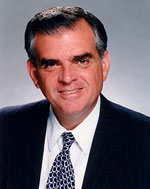Secretary of Transportation Ray LaHood warned of disruption to the nation’s air travel if automatic federal spending cuts are allowed to go through (known as the “sequester”). The Chicago Tribune reports on how such cuts would affect air travel in Illinois (emphasis added):
LaHood said the cuts will also mean the elimination of overnight shifts at 60 air traffic control towers across the country and the closure of more than 100 towers.
Under the plan, local airport towers that would see an end to overnight monitoring include Midway and two smaller airports, Dupage and Peoria International. […]
The closure list includes five Illinois airport towers: Central Illinois Regional Airport at Bloomington-Normal, Decatur Airport, Dupage in West Chicago, Southern Illinois Airport in Murphysboro and Marion County regional in Marion. […]
The National Air Traffic Controllers Association, the main union representing controllers in the U.S., said Friday’s announcement of “draconian” cuts was worse than it anticipated.
“Once towers are closed, the airports they serve may be next,” the union said in a statement. “We believe the delay estimates provided by the FAA are conservative, and the potential for disruptions could be much higher.”
In Missouri, some lawmakers are seeing LaHood’s announcement as a political ploy to pressure Congress. The Springfield, Mo., News-Leader reports:
Steve Stockam, Joplin Regional Airport manager, called the situation “extremely frustrating” and said LaHood’s announcement seemed aimed at ramping up the pressure on Congress to block the $85 billion in cuts.
“It looks like this is a political move . . . trying to get the Congress to move on some of the revenue and taxes that the administration is proposing,” Stockam said.
As for how closing towers will affect air travel at smaller airports in Missouri, the article continued:
“It continues to be extremely frustrating to us,” said Stockam, “because we just don’t understand why these types of cuts are being made that really affect public safety.”
He said the Joplin airport would not have to close even if its tower is unstaffed, because pilots can talk to each other as their planes land and take off. But it would be harder to ensure the safety of passengers without air traffic controllers guiding aircraft.
“It puts people in a greater risk because you don’t have that extra set of eyes directing traffic in and out of the facility,” he said. “You have a pilot, who is also trying to fly an airplane, trying to be a controller.”
My take: I recommend reading these articles in full. Unfortunately, I couldn’t find any local reaction from the Journal Star or the Pantagraph, but perhaps they’ll have some information later today. LaHood really comes across in these articles as a tool for the Administration, threatening to administer cuts in the most disruptive way possible in order to pressure Congress. Although he reportedly states that “safety remains the department’s top priority,” it sounds to me like, in reality, politics is the top priority. The sooner he can be replaced, the better.

 An interview with Transportation Secretary Ray LaHood was published by the
An interview with Transportation Secretary Ray LaHood was published by the